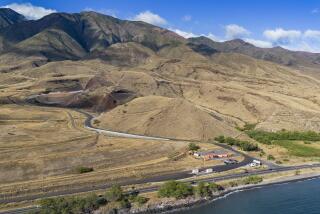Residents Vent Anger Over McColl Cleanup
An overflow crowd of people who live near the abandoned McColl toxic waste dump in Fullerton expressed anger during a state-sponsored public hearing Tuesday that the acid sludge has not been cleaned up after years of studies.
âI, for one, want to go on record saying I do not want it left on the site,â resident Joyce Curry said. âI want it removed,â she added to loud applause from the crowd of about 200 at Parks Junior High School in Fullerton.
The meeting, sponsored by the toxic substances control division of the state Health Services Department, was one in a series that is being held to receive public comment on issues to be examined in a court-ordered study of McColl cleanup alternatives and potential environmental effects.
The court order, issued last May, halted a $26.5-million Superfund project that would have excavated the McColl sludge and hauled it to a disposal facility in Kern County.
Most Appeared Skeptical
However, most people in the audience appeared skeptical that their opinions would make a difference in the final outcome of the environmental study, which is expected to be completed next year.
Considerable frustration also surfaced at an earlier public hearing Tuesday, where local government officials complained that meetings in communities where the waste could be taken were given equal time with their own.
âItâs important that the people of Orange County and the political leadership feel they are involved in the process,â said Robert Griffith, head of the countyâs hazardous waste coordination and planning department.
âIf you donât, no one is going to have any confidence in (the solution) you come up with,â Griffith told state project officials.
Ashok Ramnaney, project manager for the McColl cleanup at the state Department of Health Services, responded: âThe reason we are here today is because we did not involve the folks in Buttonwillow,â the town near the Kern County disposal site where the McColl waste was to go.
Two New Alternatives
Ramnaney added, however, that local health, water and municipal officials will meet regularly as environmental studies get under way.
He revealed that two new cleanup alternatives not previously mentioned are under study. The first would be to incinerate the toxic materials at a Carson facility now burning oil industry waste that is similar to the McColl sludge. The second would be to line the existing McColl pits to a level of protection now mandated for all hazardous waste dumps.
Ramnaney said no final decision has been made among various cleanup options. But when officials discussed the possibility of containing the sludge at the McColl site, Fullerton chief planner Barry Eaton renewed the cityâs request that the economic impact of that approach on surrounding properties be studied.
Ramnaney said a draft environmental impact report of the various alternatives would be completed by the end of this year, after which there would be 45 days for public response.
History of Dump
He said the final choice will be made jointly by state health officials and the U.S. Environmental Protection Agency, which is funding 90% of the McColl project under the federal Superfund.
The McColl dump was created in the 1940s, when oil companies producing high-octane aviation fuel deposited refinery wastes in 12 sumps on land leased by oil industry consultant Eli McColl. Oil-drilling muds later were added to six sumps, which McColl later purchased.
The dump lies beneath a vacant field and part of a golf course at the Los Coyotes Country Club and is bordered on three sides by homes in northwest Fullerton.
The refinery sludge contains sulfuric acid, arsenic and benzene, all of which are highly toxic, according to state health officials.
Concern over the dumpâs noxious odors began when the first homes were occupied near the site in 1978. Before the dump was covered two years ago with a canvas covering and earthen layers, noxious odors from the site were blamed for headaches, nausea and respiratory problems suffered by residents.
More to Read
Sign up for Essential California
The most important California stories and recommendations in your inbox every morning.
You may occasionally receive promotional content from the Los Angeles Times.










